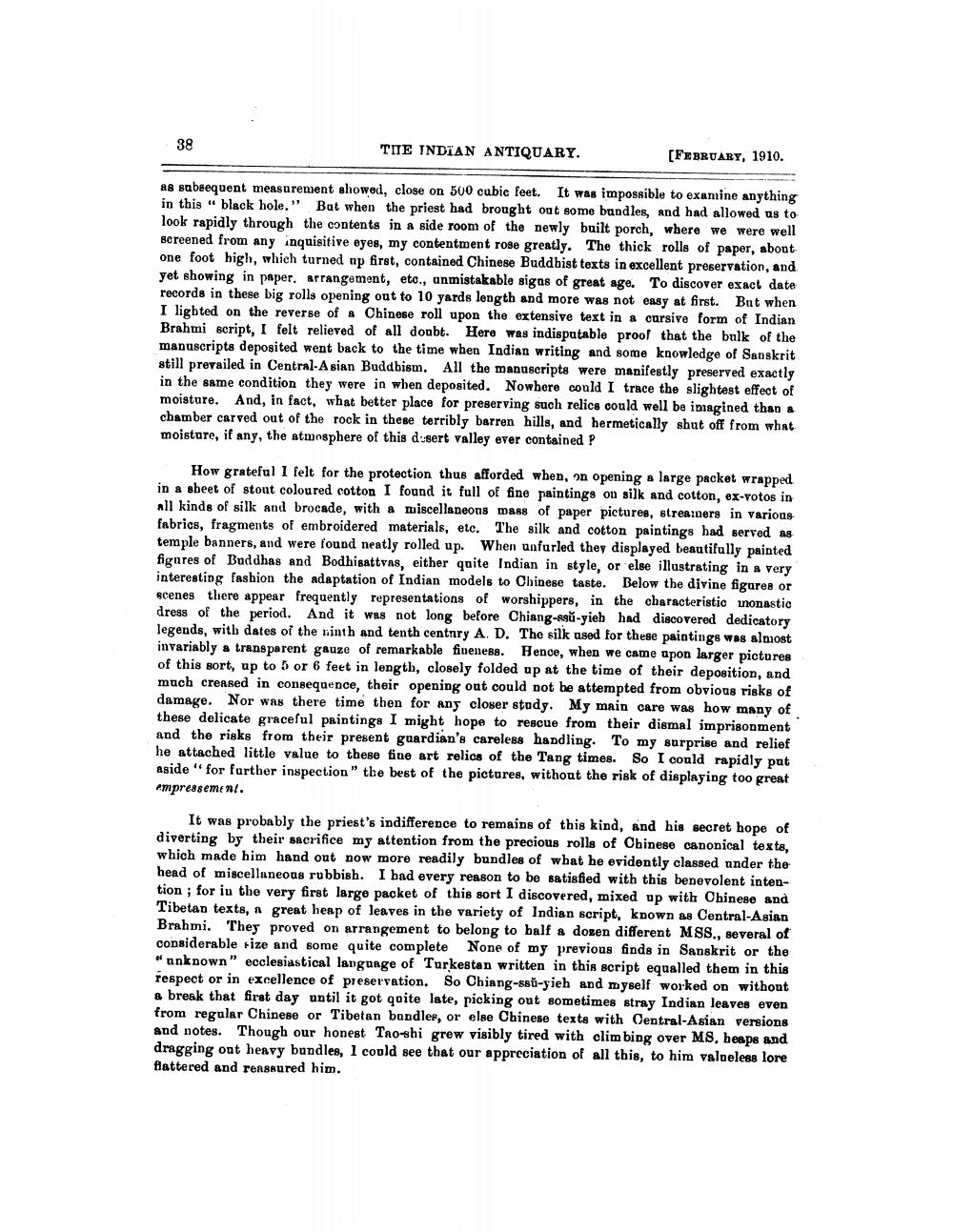________________
38
TITE INDIAN ANTIQUARY.
[FEBRUARY, 1910.
as sabeequent measurement showed, close on 500 cubic feet. It was impossible to examine anything in this black hole." But when the priest had brought out some bundles, and had allowed us to look rapidly through the contents in a side room of the newly built porch, where we were well screened from any inquisitive eyes, my contentment rose greatly. The thick rolls of paper, about one foot high, which turned up first, contained Chinese Buddhist texts in excellent preservation, and yet showing in paper, arrangement, etc., anmistakable sigas of great age. To discover exact date records in these big rolls opening out to 10 yards length and more was not easy at first. But when I lighted on the reverse of a Chinese roll upon the extensive text in a cursive form of Indian Brahmi script, I felt relieved of all doubt. Here was indisputable proof that the bulk of the manuscripts deposited went back to the time when Indian writing and some knowledge of Sanskrit still prevailed in Central-Asian Buddhism. All the manuscripts were manifestly preserved exactly in the same condition they were in when deposited. Nowhere could I trace the slightest effect of moisture. And, in fact, what better place for preserving such relics could well be imagined than a chamber carved out of the rock in these terribly barren hills, and hermetically shut off from what moisture, if any, the atmosphere of this d::sert valley ever contained P
How grateful I felt for the protection thus afforded when, on opening a large packet wrapped in a sheet of stout coloured cotton I found it full of fine paintings on silk and cotton, ex-votos in all kinds of silk and brocade, with a miscellaneons mass of paper pictures, strearners in various fabrics, fragments of embroidered materials, etc. The silk and cotton paintings had served as temple banners, and were found neatly rolled up. When unfurled they displayed beautifully painted figures of Buddhas and Bodhisattvas, either quite Indian in style, or else illustrating in a very interesting fashion the adaptation of Indian models to Chinese taste. Below the divine figures or scenes there appear frequently representations of worshippers, in the characteristic inonastic dress of the period. And it was not long before Chiang-ng-yieh had discovered dedicatory legends, with dates of the ninth and tenth centnry A. D. The silk used for these paintings was almost invariably a transparent gauze of remarkable fineness. Hence, when we came apon larger pictures of this sort, up to 5 or 6 feet in length, closely folded up at the time of their deposition, and much creased in consequence, their opening out could not be attempted from obvious risks of damage. Nor was there time then for any closer stody. My main care was how many of these delicate graceful paintings I might hope to rescue from their dismal imprisonment and the risks from their present guardian's careless handling. To my surprise and relief he attached little value to these fine art relics of the Tang times. So I could rapidly pat aside" for further inspection" the best of the pictures, without the risk of displaying too great empressement.
It was probably the priest's indifference to remains of this kind, and his secret hope of diverting by their sacrifice my attention from the precious rolls of Chinese canonical texts, which made him hand out now more readily bundles of what he evidently classed under the head of miscellaneous rubbish. I had every reason to be satisfied with this benevolent intention ; for in the very first large packet of this sort I discovered, mixed up with Chinese and Tibetan texts, a great heap of leaves in the variety of Indian script, known as Central-Asian Brahmi. They proved on arrangement to belong to half a dozen different MSS., several of considerable rize and some quite complete None of my previous finds in Sanskrit or the "unknown" ecclesiastical language of Turkestan written in this script equalled them in this respect or in excellence of preservation. So Chiang-ssd-yieh and myself worked on without a break that first day until it got quite late, picking out sometimes stray Indian leaves even from regular Chinese or Tibetan bandler, or else Chinese texts with Central-Asian versions and notes. Though our honest Taoshi grew visibly tired with climbing over MS, heaps and dragging out heavy bundles, I could see that our appreciation of all this, to him valueless lore flattered and reassured him.




